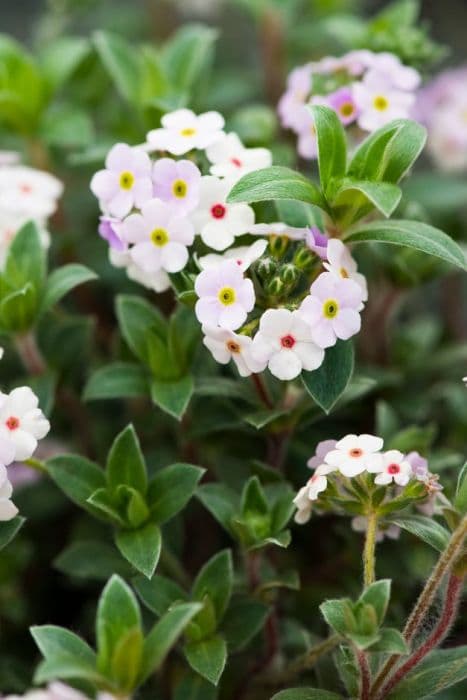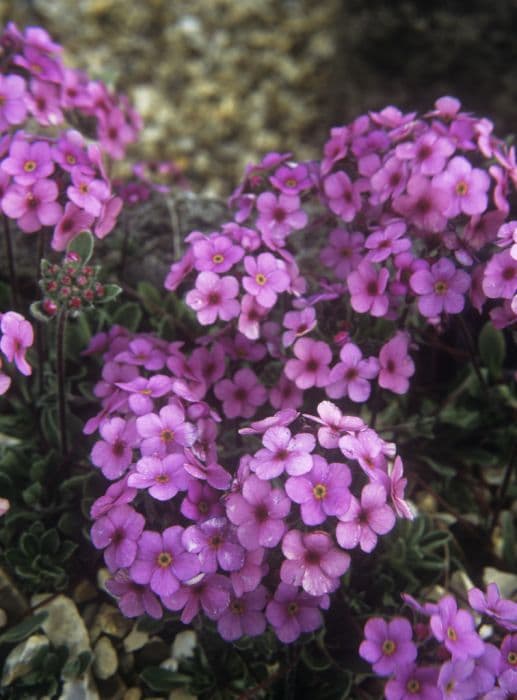Japanese Primrose Primula sieboldii 'Dancing Ladies' (Co)

ABOUT
The 'Dancing Ladies' is a captivating plant known for its beautiful floral display and attractive foliage. The flowers are the most striking feature of this plant, appearing in splendid clusters. Each individual blossom resembles a small dancer with a frilly skirt, hence the evocative name 'Dancing Ladies'. The flowers have a lovely color palette that ranges from white to various shades of pink and can sometimes include a hint of lilac. The petals are often adorned with delicate veining, which adds to their charm. The plant's leaves are another point of interest. They are willowy and soft in texture with a bright green color that forms a lush backdrop for the vibrant flowers. The leaves may be oblong or rounded, creating a foil for the much showier blooms. As the seasons change, the foliage also adds interest to the plant, with some varieties showcasing leaves that turn to attractive shades in the cooler months before dying down. Overall, the 'Dancing Ladies' presents a cheerful and delightful appearance that can liven up any garden it's a part of. Its beautiful blooms and pleasing foliage make it a favorite among garden aficionados.
About this plant
 Names
NamesSynonyms
Siebold's Primrose, Japanese Primrose, Geisha Girl.
Common names
Primula sieboldii.
 Toxicity
ToxicityTo humans
Primula sieboldii, commonly known as Siebold's primrose, has no well-documented case of toxicity to humans. Therefore, it is generally considered safe, and there are no commonly recognized symptoms of poisoning from ingesting parts of this specific plant. However, as with any plant not typically regarded as food, caution is advised, and individual allergic reactions or sensitivities could potentially occur.
To pets
Siebold's primrose is not known to be toxic to pets. There is no widely accepted evidence to suggest that this plant would cause significant symptoms or consequences if ingested by animals such as cats or dogs. Nonetheless, pet owners should monitor their pets for any unusual reactions after ingestion, as individual sensitivities can vary, and it is always best to prevent pets from eating non-food plants.
 Characteristics
CharacteristicsLife cycle
Perennials
Foliage type
Deciduous
Color of leaves
Green
Flower color
Varies
Height
0.5 feet (15 cm)
Spread
0.5 feet (15 cm)
Plant type
Herb
Hardiness zones
4
Native area
Asia
Benefits
 General Benefits
General Benefits- Aesthetic Appeal: Primula sieboldii adds color and visual interest to gardens with its vibrant blooms and attractive foliage.
- Pollinator Attraction: The flowers attract bees, butterflies, and other pollinators, which are beneficial for the garden ecosystem.
- Suitable for Shade: This plant is shade-tolerant and can thrive in areas of the garden that don't receive full sunlight.
- Seasonal Interest: It provides seasonal interest with its spring flowering period, marking the change of seasons in a garden setting.
- Low Maintenance: Primula sieboldii generally requires minimal care once established, making it ideal for gardeners of all skill levels.
- Versatility: It can be used in various garden styles, including rock gardens, woodland settings, and as border plants.
- Propagation: The plant can be easily propagated by division, allowing gardeners to create more plants for other areas of the garden or to share with others.
 Medical Properties
Medical Properties- Antispasmodic effects: Some sources suggest Primula sieboldii may have muscle relaxant properties which could alleviate spasms.
- Diuretic potential: Traditionally, parts of the plant are thought to promote urine production which can help in removing excess fluids from the body.
- Anti-inflammatory actions: The plant has been associated with reducing inflammation, potentially aiding in conditions such as arthritis or other inflammatory diseases.
- Expectorant properties: Primula sieboldii might be used to help clear mucus from the respiratory tract, aiding in conditions like bronchitis or colds.
- Immunomodulatory effects: There is some belief that the plant could have a role in modulating the immune system although scientific evidence is limited.
 Air-purifying Qualities
Air-purifying QualitiesThis plant is not specifically known for air purifying qualities.
 Other Uses
Other Uses- Artistic Inspiration: The vibrant and intricate patterns of Primula sieboldii 'Dancing Ladies' can inspire artists and designers in creating textiles, wallpaper, or other decorative items.
- Culinary Decoration: The edible flowers of 'Dancing Ladies' can be used to garnish salads, desserts, or drinks, adding a splash of color and a subtle floral note.
- Photography Subject: The unique appearance of Primula sieboldii 'Dancing Ladies' makes it an excellent subject for photographers, particularly those specializing in botanical photography.
- Symbolic Gift: Due to its beauty, 'Dancing Ladies' can be used as a symbolic gift to represent delicacy and enduring charm in various cultures.
- Therapeutic Horticulture: Gardening with 'Dancing Ladies' can be used as a therapeutic activity to improve mental health and well-being.
- Educational Tool: The plant can be employed in educational settings to teach about botanical intricacies, plant lifecycles, and artistic patterns in nature.
- Event Decoration: The flowers can serve as delicate table centerpieces or decorations for springtime events such as weddings or garden parties.
- Floral Arrangements: 'Dancing Ladies' can be incorporated into fresh floral arrangements for a touch of whimsy and grace.
- Butterfly Garden Addition: Primula sieboldii 'Dancing Ladies' attracts butterflies, making it a valuable addition to butterfly gardens and contributing to local biodiversity.
- Craft Projects: The flowers of the plant can be used for pressing and included in handcrafted greeting cards, bookmarks, or other personalized gifts.
Interesting Facts
 Feng Shui
Feng ShuiThe Japanese primrose is not used in Feng Shui practice.
 Zodiac Sign Compitability
Zodiac Sign CompitabilityThe Japanese primrose is not used in astrology practice.
 Plant Symbolism
Plant Symbolism- Renewal and Hope: The 'Dancing Ladies' Primula often blooms in early spring, symbolizing the end of winter and the coming of spring, which brings with it new growth and the hope of a new beginning.
- Love and Affection: Primulas have long been associated with love and affection in various cultures, possibly because of their heart-shaped leaves or vibrant colors. 'Dancing Ladies', with their graceful appearance, can be reminiscent of the delicate nature of love.
- Happiness and Joy: The lively appearance and bright colors of the 'Dancing Ladies' Primula can evoke feelings of happiness and joy, making them a symbol of cheerful emotions and positivity.
- Perseverance and Courage: These flowers emerge after the cold of winter, often while the last frost is still a threat. This hardiness symbolizes perseverance and the courage to face challenges.
 Water
WaterJapanese Primrose, commonly known as 'Dancing Ladies,' prefers consistently moist soil and should not be allowed to dry out completely. You should water this plant once or twice a week, providing enough water to soak the soil thoroughly each time. During the active growing season, typically in the spring and early summer, it may require watering every 2-3 days, depending on the weather conditions. It's generally recommended to use about 1 gallon of water per plant for each watering session. Ensure proper drainage to prevent waterlogging, which can cause root rot.
 Light
LightJapanese Primrose or 'Dancing Ladies' thrives best in partial shade or filtered sunlight. It should be placed in a location where it receives morning sun and is protected from the harsh afternoon rays, which can scorch its delicate leaves. Bright, indirect light throughout the day is ideal for promoting vibrant blooms without putting the plant under stress from overexposure.
 Temperature
TemperatureJapanese Primrose or 'Dancing Ladies' prefers cooler temperatures and can endure temperatures as low as 20°F for short periods. However, the ideal growing conditions are between 50°F and 65°F. They should be protected from extreme heat, generally above 80°F, which can adversely affect their growth and flowering.
 Pruning
PruningJapanese Primrose, also known as 'Dancing Ladies', requires minimal pruning. Deadheading spent flowers encourages further blooming and maintains the plant's appearance. After blooming has finished, usually in late spring or early summer, trim back the foliage to promote healthy growth for the next season. Pruning should ideally be done promptly after flowering to prepare the plant for its dormant phase.
 Cleaning
CleaningAs needed
 Soil
SoilSiebold's Primrose prefers well-draining, humus-rich soil with a pH of 6.0 to 7.0. A mix of loam, sand, and peat works well for good aeration and moisture retention.
 Repotting
RepottingSiebold's Primrose should be repotted every 1-2 years or when root bound, typically in the early spring before new growth starts.
 Humidity & Misting
Humidity & MistingSiebold's Primrose thrives best at humidity levels between 50% and 70%, similar to the moist environments they prefer in nature.
 Suitable locations
Suitable locationsIndoor
Keep in bright indirect light, at cool temps, with high humidity.
Outdoor
Plant in partial shade, in moist, well-drained soil.
Hardiness zone
4-8 USDA
 Life cycle
Life cyclePrimula sieboldii 'Dancing Ladies', commonly known as Japanese primrose, begins its cycle when seeds germinate in moist, well-drained soil, usually in spring. The seedlings develop into rosettes of leaves. In their second year, the rosettes produce flowering stems in late spring to early summer, which can be quite variable and may be pink, white, or purple with a distinct snowflake or fringed pattern. After flowering, the plant sets seed, and the foliage often goes dormant, disappearing in the summer only to re-emerge in the fall or following spring. Vegetative propagation can occur through division of the rosettes, typically done in the fall. Over the winter, Primula sieboldii's foliage persists if the climate is mild, but protects itself through dormancy in colder climates, resuming growth and completing the cycle as temperatures rise again in spring.
 Propogation
PropogationPropogation time
Spring-Early Summer
Primula sieboldii 'Dancing Ladies', commonly known as Siebold's primrose, is often propagated by division, which is the most popular method for this plant. This process is typically carried out in late summer after the plants have finished flowering. To propagate by division, the gardener should carefully dig up the clump and gently separate the roots into smaller clumps, making sure that each new section has a healthy portion of roots and a few leaves. These divisions should then be replanted in moist, well-draining soil at the same depth they were growing before, ideally spaced about 12 inches (approximately 30 centimeters) apart to allow for growth. Water the newly planted divisions regularly to help establish them. With proper care, these divisions will grow into full-sized plants and flower in the next season.









